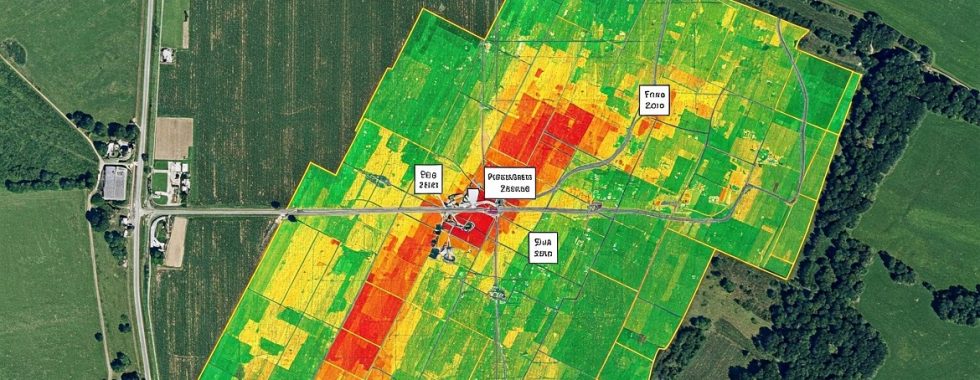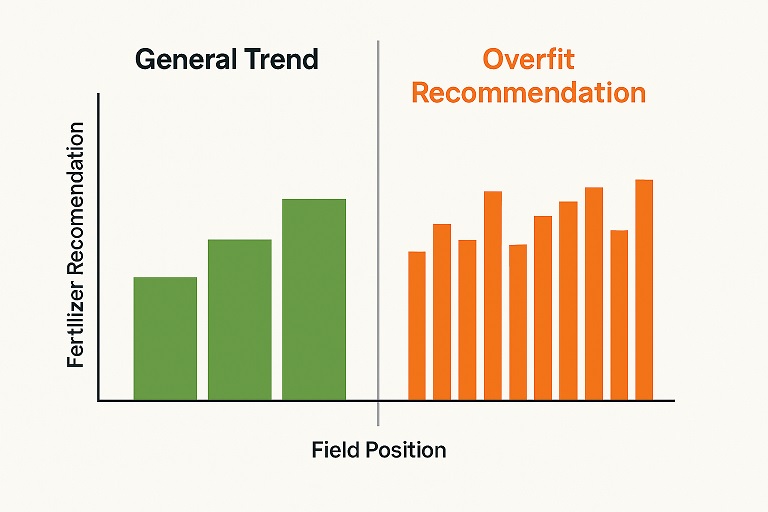The Illusion of Precision in Agriculture: Are We Managing Fields or Chasing Noise?
Precision agriculture has enabled unprecedented fine-tuning of crop management – from variable-rate fertilization to micro-zone irrigation. Growers and agronomists can now make site-specific decisions and respond to variability within a field like never before.
But how precise is too precise?
There is a point where ultra site-specific recommendations can lead to agronomic inefficiencies, unnecessary complexity, and poor return on investment (ROI). This phenomenon is comparable to overfitting in data science, where a model becomes so tailored to the data that it ends up responding to noise rather than meaningful patterns.
The same can happen in the field. And it comes with agronomic, operational, and economic costs.
What Is Overfitting in Agriculture?
In data science, overfitting happens when an algorithm is too tightly tuned to a specific dataset. It performs well on that data but poorly on new data, because it has learned quirks rather than general trends.
Translating that to agriculture: imagine we have dense soil test data across a field and create a different fertilizer blend for every slight variation. While this feels data-driven, we may be responding to random fluctuations – sampling errors, lab noise, or one-off anomalies – rather than meaningful differences.
Of course, real variability exists. Soil texture, organic matter, and yield potential can vary within a field. But when we take site-specificity too far, we risk building prescriptions on noise instead of signal. The outcome is often a needlessly complex and expensive fertilizer plan that offers no real agronomic benefit. What looks like precision quickly turns into pseudo-precision – a detailed map that appears sophisticated but delivers little or no improvement in crop performance.
When Site-Specific Precision Overfits the Field
Several factors contribute to over-precision and should be carefully considered when designing field prescriptions:
Sampling and lab variability
Soil sampling itself introduces uncertainty. Small differences between adjacent zones can result from how the sample was collected or processed, not actual soil differences. When those small differences are treated as meaningful, the resulting recommendations are inherently unstable.
Biological buffering
It’s important to remember that crops and soils have a buffering capacity. A slight difference in soil nutrient level between two spots doesn’t always translate to a yield difference, because of factors like root systems and nutrient mobility. Plants explore a volume of soil; they may draw nutrients from surrounding areas, effectively averaging out micro-heterogeneity. Furthermore, the law of diminishing returns in crop response means that once you approach a nutrient-sufficient level, extra fertilizer yields little or no gain.
For example, this biological reality implies that a 5 or 10 ppm difference in soil test P between two sub-zones might not warrant two distinct P rates as both areas could produce the same yield if both are above the critical level. Over-precision would ignore this buffering, attempting to fine-tune beyond what the crop can even respond to.
Temporal anomalies
Fields are subject to weather and other temporal factors that can create one-off patterns. A single year’s yield map, for instance, might show a patch of low yield in one corner. But perhaps that patch suffered a freak waterlogging or a localized pest issue that year – it might yield normally in other years. If we treat that one-year anomaly as a fixed truth and pour extra fertilizer there (assuming the soil is deficient), we may be misallocating resources.
In fact, temporal variance can be as large or larger than spatial variance in yield maps.
Complexity and implementation errors
From a practical standpoint, highly granular management zones increase complexity during application. More zones mean more chances of equipment mis-calibration, prescription file errors, or simply management overwhelm.
If a nutrient map has dozens of tiny polygons each with a different rate, the sprayer or spreader is doing constant changes – the risk of mistakes or mechanical issues rises. We might call this an “operational overfit” – a plan so complicated that it’s prone to failure in the real world. While this isn’t a data noise issue per se, it’s a related pitfall of over-precision. Simpler plans often end up being more faithfully executed.
Real-World Signs of Over-Precision
Across farms and regions, we’ve seen clear examples of over-precision backfiring:
- Too many fertilizer mixes: Some farms end up with 10+ different blends for a single field, each tailored to one acre zone. This introduces complexity in logistics, application, and record-keeping, often without measurable yield improvement.
- Mismatch between soil tests and yield: In some cases, hyper-detailed soil sampling leads to recommendations that don’t correlate with actual crop performance. This frustrates growers and undermines trust in precision ag tools.
- Poor ROI from ultra-dense sampling: High-resolution grid sampling is expensive. If the resulting map doesn’t lead to meaningful or profitable decisions, that investment is hard to justify.
- Operational failure: Equipment miscalibration, application errors, or file mix-ups become more common when field plans are too complex. Simpler, robust strategies often perform better under real-world conditions.
How to Avoid Overfitting in the Field
Precision agriculture is still the future – when applied wisely. Here’s how to avoid the trap of over-precision:
1. Focus on economically significant variability – Not all differences are worth acting on. Use nutrient response thresholds and agronomic logic to group zones into categories that matter, such as low, medium, and high. Don’t chase tiny numerical differences unless they clearly affect crop response or profit.
2. Aggregate data and validate patterns – Look for consistency across years and datasets. A nutrient deficiency that shows up in multiple seasons and correlates with yield or tissue tests is worth targeting. A single low-test result in a single season? That’s a red flag, not a green light.
3. Balance precision with simplicity – Aim for a manageable number of fertility zones – ideally 3 to 5 per field. This ensures plans are executable and understandable, while still targeting real variability. Group zones based on shared traits like soil texture, topography, or stable productivity levels.
4. Use decision-support systems with built-in guardrails – Platforms like yieldsApp integrate AI to interpret complex datasets without falling into the overfitting trap. Instead of blindly responding to every small data fluctuation, yieldsApp contextualizes information, such as soil tests, sensor data, weather, and historical performance to provide validated, field-specific recommendations. This kind of smart decision support bridges the gap between raw precision and real-world agronomy.
5. Conduct on-farm trials to confirm assumptions – Before rolling out hyper-specific plans across an entire field, run strip trials. Apply the proposed differentiated treatment alongside a standard one. Compare results, not just visually, but with yield monitors or other quantitative tools. Let your own field validate your data interpretation.
Precision with Purpose
Precision agriculture is not about making things more complicated. It’s about being intentional and efficient – applying the right input, at the right rate, in the right place, at the right time. Over-precision undermines that goal. When nutrient plans respond to noise rather than signals, complexity rises, ROI falls, and agronomic integrity suffers.
In the end, it’s not about how many zones you have – it’s about whether they make sense, deliver value, and support better farming decisions.




